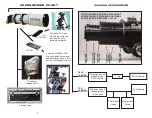
FOCUSER
ADJUSTMENT
if you find the focuser slips when
heavy accessories are used, tighten
the thumb screw (a) underneath the
focus shaft slightly to eliminate slip-
page. also, tighten thumb screw (a1)
if the focuser drawtube has any play.
ROTATING THE
FOCUSER
there is a thumb screws (b) between
the focuser and the main tube.
loosen this slightly to rotate the
focuser 360 degrees. there are three
set screws (c) that adjust tension of
the rotator. make sure each of these
is equally tight so rotation is stiff. if they are too loose the focuser could slightly
misalign, so be sure these screws are adequately tight before imaging to elimi-
nate any misalignment.
when imaging, after you attain focus, tighten the top screw (a1) to eliminate
focus shift during the exposure.
ic2177 emission nebula in canis major/monoceros by frank dibble.
4.
ASTROPHOTOGRAPHY
good astrophotography requires a good telescope mount. equatorial mounts are
best: alt azimuth tracking mounts cause field rotation during longer exposures,
turning the stars into arcs. equatorial mounts with low periodic error track the stars
accurately if your telescope mount is properly aligned to the celestial pole. less
expensive mounts will not track accurately enough to show all your telescope is
capable of capturing. your telescope is excellent both optically and mechanically,
so we advise you not to cut corners on the mount if you intend to engage in
astrophotography. check our website for recommended mounts for your telescope.
SVQ100 Images by Dave Weixelman
6.
A
A1
b
C
Double Cluster
Pleiades















